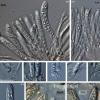
12-11-2021 00:03
Lepista ZacariasHi everybody,A week ago in my fiels trip I noticed

29-12-2025 17:44
Isabelle CharissouBonjour,J'aimerais savoir si d'autres personnes au

29-12-2025 17:12
 Bernard CLESSE
Bernard CLESSE
Bonjour à toutes et tous,Pourriez-vous m'aider à

29-12-2025 17:01
Gernot FriebesHi,I'm looking for help with this hyphomycete with

29-12-2025 08:30
Hello.A tiny ascomycete sprouting under Juniperus

29-12-2025 10:15
Hulda Caroline HolteHello, I found and collected this propoloid ascom

29-12-2025 09:38
Oskari VirtanenHi,could anyone help me identify this, I suspect P
Possible Calycellina from eastern Spain
Garrido-Benavent Isaac,
21-02-2014 12:12
I'm Isaac Garrido Benavent, from Spain. This is my first mail to Ascofrance. I'm looking forward to participate here, and learn as much as possible about ascomicetes.
I'm dealing with a species that supposedly belongs to the genus Calycellina, but I'm not convinced at all. It was found growing on dead leaves of Quercus coccifera in a ravine located in southern Valencia (eastern Spain) at 200 m asl. Some data:
- Asci 50-63 x 7-8 um, with croziers, with less than 8 spores (normally 6), abundant granular content, and a distinct apical aparatus which is shown in the photos.
- Paraphyses from 65 to 70 um length, scarcely septate, with somewhat widened apices up to (2)2'4-3'6(4') um (slightly clavate).
- Spores (12)15-17'3(19'4) x 2'5-3'6 um, fusiform, with rounded ends, slightly or not curved, non septate, hyaline, with abundant granular content and 1 to 3 greater guttules.
- Excipulum hairs visible under dissecting microscope, 17-32 x 2'7-4'2 um size, greyish brown (somewhat yellowish in lugol), septate, apparently smooth, more or less cylindrical, tortuose, and with somewhat narrowed apices.
- Macroscopically, the diameter of the apothecia less than 2 mm.
Any suggestion would be appreciated. Thanks in advance!!
Regards,
Isaac
Hans-Otto Baral,
21-02-2014 21:14

Re : Possible Calycellina from eastern Spain
Dear Isaac
welcome to the forum!
I have no clear idea about your fungus although you show a lot of details. What I miss is a section of the excipulum, is it a gelatinized, and what cell shape ans colour.
From the hairs I actually suspect a Calycellina (or Phialina when accepting that genus). Important would be to study living asci and paraphyses/hairs. The latter might have contained refractive vacuoles, and the spore number would better be seen inside the asci (4-6-spored?).
Zotto
welcome to the forum!
I have no clear idea about your fungus although you show a lot of details. What I miss is a section of the excipulum, is it a gelatinized, and what cell shape ans colour.
From the hairs I actually suspect a Calycellina (or Phialina when accepting that genus). Important would be to study living asci and paraphyses/hairs. The latter might have contained refractive vacuoles, and the spore number would better be seen inside the asci (4-6-spored?).
Zotto
Garrido-Benavent Isaac,
22-02-2014 09:07
Re : Possible Calycellina from eastern Spain
Dear Zotto,
Thank you very much for your answer. You provided me some hints on what characters are more useful for studying this group. So, despite the specimens are actually dried, I will try to get some of the relevant traits you told me as soon as possible.
Enjoy the weekend!!
Regards,
Isaac
Thank you very much for your answer. You provided me some hints on what characters are more useful for studying this group. So, despite the specimens are actually dried, I will try to get some of the relevant traits you told me as soon as possible.
Enjoy the weekend!!
Regards,
Isaac




